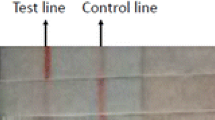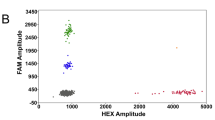Abstract
This study evaluates the performance of different detection protocols of Vibrio parahaemolyticus in frozen prawns. The effect of enrichment and incubation temperature on the selectivity of thiosulfate citrate bile sucrose (TCBS) and CHROMagar™ Vibrio (CAV) media were determined. Enumeration of V. parahaemolyticus in frozen prawns by direct-plating on CAV at 37 °C yielded the highest count compared to the other tested direct-plating protocols (p < 0.05). The enrichment step was found to increase the selectivity of TCBS for V. parahaemolyticus but did not affect the selectivity of CAV. Furthermore, trh + V. parahaemolyticus isolates were only successfully recovered from CAV, suggesting that CAV is the better media for the detection of virulent V. parahaemolyticus compared to TCBS. Repetitive Extragenic Palindromic PCR typing (REP-PCR) indicated that CAV and TCBS, as well as direct-plating or enrichment-plating are selective for different subsets of V. parahaemolyticus present in a sample. In conclusion, the current work suggests that CAV is a better selective media for detection and isolation of V. parahaemolyticus in frozen prawns. This study also suggests that direct-plating on CAV with an incubation temperature of 35–37 °C could be an alternative to Most Probable Number (MPN)-PCR for enumeration of V. parahaemolyticus in frozen prawn samples.



Similar content being viewed by others

References
Anupama KP, Deeksha K, Deeksha A, Karunasagar I, Karunasagar I, Maiti B (2019) Comparative performance of TCBS and TSA for the enumeration of trh + Vibrio parahaemolyticus by direct colony hybridization. J Microbiol Methods 157:37–42
Banerjee SK, Farber JM (2017) Detection, enumeration, and isolation of Vibrio parahaemolyticus and V. vulnificus from seafood: development of a multidisciplinary protocol. J AOAC Int 100(2):445–453
Bej AK, Patterson DP, Brasher CW, Vickery MC, Jones DD, Kaysner CA (1999) Detection of total and hemolysin-producing Vibrio parahaemolyticus in shellfish using multiplex PCR amplification of tl, tdh and trh. J Microbiol Methods 36:215–225
Beuchat L (1977) Suitability of some enrichment broths and diluents for enumerating cold-and heat-stressed Vibrio parahaemolyticus. Can J Microbiol 23:630–633
Blanco-Abad V, Ansede-Bermejo J, Rodriguez-Castro A, Martinez-Urtaza J (2009) Evaluation of different procedures for the optimized detection of Vibrio parahaemolyticus in mussels and environmental samples. Int J Food Microbiol 129:229–236
Canizalez-Roman A, Flores-Villaseñor H, Zazueta-Beltran J, Muro-Amador S, León-Sicairos N (2011) Comparative evaluation of a chromogenic agar medium–PCR protocol with a conventional method for isolation of Vibrio parahaemolyticus strains from environmental and clinical samples. Can J Microbiol 57:136–142
Centers for Disease Control and Prevention (2017) Vibrio species causing Vibriosis. https://www.cdc.gov/vibrio/faq.html. Accessed 02 Mar 2017
DePaola A, Hopkins L, Peeler J, Wentz B, McPhearson R (1990) Incidence of Vibrio parahaemolyticus in US coastal waters and oysters. Appl Environ Microbiol 56:2299–2302
Di Pinto A, Terio V, Novello L, Tantillo G (2011) Comparison between thiosulphate-citrate-bile salt sucrose (TCBS) agar and CHROMagar Vibrio for isolating Vibrio parahaemolyticus. Food Control 22:124–127
García K, Torres R, Uribe P, Hernández C, Rioseco ML, Romero J, Espejo RT (2009) Dynamics of clinical and environmental Vibrio parahaemolyticus strains during seafood-related summer diarrhea outbreaks in southern Chile. Appl Environ Microbiol 75:7482–7487
Hara-Kudo Y, Nishina T, Nakagawa H, Konuma H, Hasegawa J, Kumagai S (2001) Improved method for detection of Vibrio parahaemolyticus in seafood. Appl Environ Microbiol 67:5819–5823
Jiang X, Chai TJ (1996) Survival of Vibrio parahaemolyticus at low temperatures under starvation conditions and subsequent resuscitation of viable, nonculturable cells. Appl Environ Microbiol 62:1300–1305
Kaufman G, Blackstone G, Vickery M, Bej A, Bowers J, Bowen MD, Meyer RF, DePaola A (2004) Real-time PCR quantification of Vibrio parahaemolyticus in oysters using an alternative matrix. J Food Prot 67:2424–2429
Kaysner CA, Tamplin ML, Wekell MM, Stott RF, Colburn KG (1989) Survival of Vibrio vulnificus in shellstock and shucked oysters (Crassostrea gigas and C. virginica) and effects of isolation medium on recovery. Appl Environ Microbiol 55:3072–3079
Kim DG, Ahn SH, Kim LH, Park KJ, Hong YK, Kong IS (2008) Application of the rpoS gene for species-specific detection of Vibrio vulnificus by real-time PCR. J Microbiol Biotechnol 18:1841–1847
Kourany M (1983) Medium for isolation and differentiation of Vibrio parahaemolyticus and Vibrio alginolyticus. Appl Environ Microbiol 45:310–312
Lucht L, Blank G, Bousa J (1998) Recovery of foodborne microorganisms from potentially lethal radiation damage. J Food Prot 61:586–590
Mackey BM (1984) Lethal and sublethal effects of refrigeration, freezing and freeze-drying on micro-organisms. In: Andrew MHE, Russell AD (eds) The revival of injured microbes. Academic Press, London, pp 45–75
Martinez-Urtaza J, Lozano-Leon A, Varela-Pet J, Trinanes J, Pazos Y, Garcia-Martin O (2008) Environmental determinants of the occurrence and distribution of Vibrio parahaemolyticus in the rias of Galicia, Spain. Appl Environ Microbiol 74:265–274
Miwa N, Nishio T, Arita Y, Kawamori F, Masuda T, Akiyama M (2003) Evaluation of MPN method combined with PCR procedure for detection and enumeration of Vibrio parahaemolyticus in seafood. Shokuhin Eiesigaku Zasshi 44:289–293
Navia MM, Capitano L, Ruiz J, Vargas M, Urassa H, Schellemberg D, Gascon J, Vila J (1999) Typing and characterization of mechanisms of resistance of Shigella spp. isolated from feces of children under 5 years of age from Ifakara, Tanzania. J Clin Microbiol 37:3113–3117
Nemoto J, Ikedo M, Kojima T, Momoda T, Konuma H, Hara-Kudo Y (2011) Development and evaluation of a loop-mediated isothermal amplification assay for rapid and sensitive detection of Vibrio parahaemolyticus. J Food Prot 74:1462–1467
Newton A, Kendall M, Vugia DJ, Henao OL, Mahon BE (2012) Increasing rates of vibriosis in the United States, 1996–2010: review of surveillance data from 2 systems. Clin Infect Dis 54:S391–S395
Nigro OD, Steward GF (2015) Differential specificity of selective culture media for enumeration of pathogenic vibrios: advantages and limitations of multi-plating methods. J Microbiol Methods 111:24–30
Nordin N, Yusof NA, Abdullah J, Radu S, Hushiarian R (2017) A simple, portable, electrochemical biosensor to screen shellfish for Vibrio parahaemolyticus. Amb Express 7:41
Nordstrom JL, DePaola A (2003) Improved recovery of pathogenic Vibrio parahaemolyticus from oysters using colony hybridization following enrichment. J Microbiol Methods 52:273–277
Paydar M, Teh CSJ, Thong KL (2013) Prevalence and characterisation of potentially virulent Vibrio parahaemolyticus in seafood in Malaysia using conventional methods, PCR and REP-PCR. Food Control 32:13–18
Raghunath P, Acharya S, Bhanumathi A, Karunasagar I, Karunasagar I (2008) Detection and molecular characterization of Vibrio parahaemolyticus isolated from seafood harvested along the southwest coast of India. Food Microbiol 25:824–830
Ray B, Hawkins SM, Hackney CR (1978) Method for the detection of injured Vibrio parahaemolyticus in seafoods. Appl Environ Microbiol 35:1121–1127
Su Y-C, Liu C (2007) Vibrio parahaemolyticus: a concern of seafood safety. Food Microbiol 24 (6):549-558
Su YC, Duan J, Wu WH (2005) Selectivity and specificity of a chromogenic medium for detecting Vibrio parahaemolyticus. J Food Prot 68:1454–1456
Tada J, Ohashi T, Nishimura N, Shirasaki Y, Ozaki H, Fukushima S, Takano J, Nishibuchi M, Takeda Y (1992) Detection of the thermostable direct hemolysin gene (tdh) and the thermostable direct hemolysin-related hemolysin gene (trh) of Vibrio parahaemolyticus by polymerase chain reaction. Mol Cell Probes 6:477–487
Ward LN, Bej AK (2006) Detection of Vibrio parahaemolyticus in shellfish by use of multiplexed real-time PCR with TaqMan fluorescent probes. Appl Environ Microbiol 72:2031–2042
Wesche AM, Gurtler JB, Marks BP, Ryser ET (2009) Stress, sublethal injury, resuscitation, and virulence of bacterial foodborne pathogens. J Food Prot 72:1121–1138
Yamazaki W, Kumeda Y, Uemura R, Misawa N (2011) Evaluation of a loop-mediated isothermal amplification assay for rapid and simple detection of Vibrio parahaemolyticus in naturally contaminated seafood samples. Food Microbiol 28:1238–1241
Yu WT, Jong KJ, Lin YR, Tsai SE, Tey YH, Wong HC (2013) Prevalence of Vibrio parahaemolyticus in oyster and clam culturing environments in Taiwan. Int J Food Microbiol 160:185–192
Acknowledgements
This research was financially supported by University of Malaya High Impact Research Grant UM (UM.C/625/1/HIR/MOE/SC/20) and UMRG (RP003C-13BIO). We would also like to acknowledge the laboratory facilities provided by faculty of science, University of Malaya.
Funding
This study was funded by University of Malaya High Impact Research Grant UM (UM.C/625/1/HIR/MOE/SC/20) and UMRG (RP003C-13BIO) to Lay Ching Chai and Kwai Lin Thong.
Author information
Authors and Affiliations
Corresponding author
Ethics declarations
Conflict of interest
Salima Sadeghi, Kwai Lin Thong, Lay Ching Chai declare that they have no conflict of interest.
Ethical approval
This article does not contain any studies with human participants or animals performed by any of the authors.
Additional information
Publisher's Note
Springer Nature remains neutral with regard to jurisdictional claims in published maps and institutional affiliations.
Rights and permissions
About this article
Cite this article
Sadeghi, S., Thong, K.L. & Chai, L.C. Pre-enrichment step, incubation temperature and type of selective media affect the pathogenic Vibrio parahaemolyticus detection efficiency in frozen prawns. J Consum Prot Food Saf 14, 355–364 (2019). https://doi.org/10.1007/s00003-019-01237-1
Received:
Revised:
Accepted:
Published:
Issue Date:
DOI: https://doi.org/10.1007/s00003-019-01237-1



